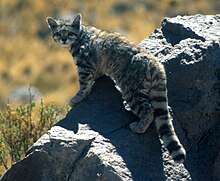Andean mountain cat
| Andean mountain cat | |
|---|---|
 |
|
| Andean mountain cat | |
| Scientific classification | |
| Kingdom: | Animalia |
| Phylum: | Chordata |
| Class: | Mammalia |
| Order: | Carnivora |
| Family: | Felidae |
| Genus: | Leopardus |
| Species: | L. jacobita |
| Binomial name | |
|
Leopardus jacobita (Cornalia, 1865) |
|
 |
|
| Geographic range | |
| Synonyms | |
|
Oreailurus jacobita |
|
Oreailurus jacobita
The Andean mountain cat (Leopardus jacobita) is a small wild cat native to the high Andes that has been classified as Endangered by IUCN because fewer than 2,500 individuals are thought to exist in the wild.
It was first described by Emilio Cornalia who named it in honour of Jacobita Mantegazza. It is one of only two cat species for which no subspecies has been described.
The Andean mountain cat has an ashy-gray fur, a gray head, ears and face. The areas around the lips and cheeks are white; two dark brown lines run from the corners of the eyes across the cheeks. There are some black spots on the forelegs, yellowish-brown blotches on the flanks, and up to two narrow, dark rings on the hind limbs. The long bushy tail has 6–9 rings, which are dark brown to black. The markings of juveniles are darker and smaller than of adults. The skulls of adult specimens range in length from 100.4 to 114.8 mm (3.95 to 4.52 in) and are larger than of pampas cat and domestic cat.
The Andean mountain cat has a black nose and lips, and rounded ears. On the back and on the tail, the hair is 40–45 mm (1.6–1.8 in) long. Its rounded footprints are 4 cm (1.6 in) long and 3.5 cm (1.4 in) wide. Its pads are covered with hair.
Adult specimens range from 57.7 to 85 cm (22.7 to 33.5 in) in head-to-body length, with a 41.3 to 48.5 cm (16.3 to 19.1 in) long tail. The shoulder height is about 36 cm (14 in) and body weight is up to 5.5 kilograms (12 lb).
The Andean mountain cat and pampas cat look similar. This makes it difficult to identify which cat is observed and makes correct estimations of populations problematic. This can be especially difficult when attempting to gain correct information from the observations of individuals that have seen one of these cats but are not aware to look for specific features to distinguish between the two.
Andean mountain cats occur only at high elevations in the Andes. Records in Argentina indicate that they live at elevations from 1,800 m (5,900 ft) in the southern Andes to over 4,000 m (13,000 ft) in Chile, Bolivia and central Peru. This terrain is arid, sparsely vegetated, rocky and steep. The population in the Salar de Surire Natural Monument was estimated at five individuals in an area of 250 km2 (97 sq mi). Results of a survey in the Jujuy Province of northwestern Argentina indicates a density of seven to 12 individuals per 100 km2 (39 sq mi) at an elevation of about 4,200 m (13,800 ft).
...
Wikipedia

